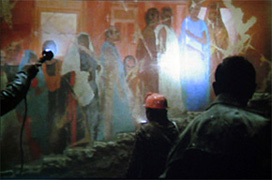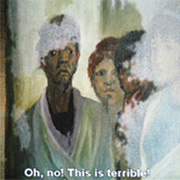 1
1Porn gets in on the act
It was not only mainstream film that exploited Roman culture. The most expensive pornographic movie ever made, or so it’s marketing would have us believe, was also based on a Roman theme. Made in 2003 in Eastern Europe, Private Gladiator was promoted as the first pornographic film to ‘lavishly recreate the hedonistic splendours of ancient Rome’ (fig.1). According to the now obligatory film about the making of the film, no expense was spared during the making of its sets and costumes. Its pre-publicity is a parody of the kind of marketing hype that surrounds mainstream toga movies. It even quantifies (presumably tongue-in-cheek) the number of grains of sand that it took to cover the Gladiatorial arena in its cardboard cut out version of the Colosseum. Predictably, the reality falls short of the marketing. The costumes and sets are meaningless because they are produced with the sole purpose of delivering the ‘money shot’. In keeping with this genre the narrative is minimal and only serves to link the various scenes made up of different groupings of copulating figures. The Roman context is simply constructed via clichéd versions of men in leather skirts and women in white sheets, set against a backdrop of columns, couches and vague references to wall-paintings. Although the movie’s Roman setting is undoubtedly 'tongue-in-cheek', it is still one more manifestation of the way in which antiquity is skewed by contemporary cultural filters.
Returning to the Present
Screen based culture remains one of the most dominant filters shaping our view of Roman wall-painting. Even though decades have passed since the Italian film industry began creating Roman epic films, which Hollywood later turned into spectacular toga movies, and directors such as Federico Fellini and Jean-Luc Godard made films such as Roma and Le Mépris satirising the way in which Hollywood and early Italian cinema turned history into spectacular entertainment (fig.2&3). The absurdity of the religio-politico machinations associated with toga movies is explored to side-splitting effect in Hail Caesar (Ethan and Joel Coen, 2016).
As both a film director and an Italian Fellini was acutely aware of the way in which his country’s historical identity had been manipulated and reinvented through the medium of film. His elegiac masterpiece Roma (1972) continually exposes us to the frenetic pace of modern Rome, whilst reminding us that above and beneath its streets fragments of its ancient past are all around us, both affecting us and being affected by us. This is poignantly symbolised in a sequence in which tunneling equipment for Rome’s new Underground system, detects the presence of a subterranean chamber. Archaeologists make the final tentative breakthrough into what appears to be either a temple or burial chamber with walls covered in figurative paintings (fig.4). As the archaeologists peer into the chamber air also rushes in and the figures on the opposing wall immediately begin to disintegrate, as though contaminated by exposure to the modern world (fig.5). This beautifully engineered sequence by a director who once said he wanted to be a painter, perfectly encapsulates the physical and conceptual fragility of Roman wall-painting when it is exposed to the present.
 1
1 4
4 5
5
|